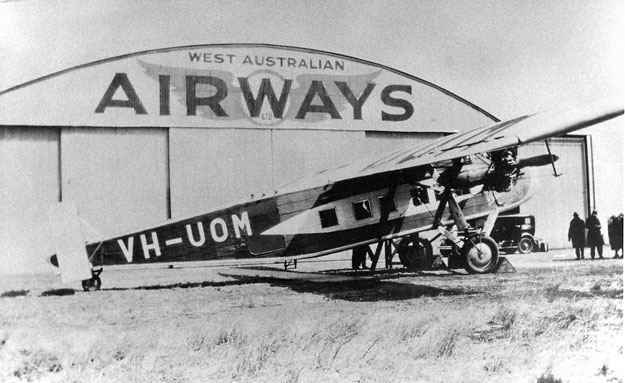
In 1928 West Australian
Airways won the contract offered by the CAB
to establish an air service between Perth and Adelaide using de Havilland
D.H.66 Hercules aircraft. The D.H.66 was a huge aircraft for its day,
and special hangars were constructed at Perth/Maylands, Adelaide/Parafield
and Forrest,
on the Nullarbor Plain, to house them. All of these hangars survive to
this day (2008) and are among the oldest surviving hangars in Australia.
Hangar No 1 at Maylands was designed by architects Oldham Boas & Ednie-Brown and erected by Finlay and Stoneman. The framework of the hangar is Australian steel, clad with galvanised, corrugated iron, and measures 37 m long by 37.25 m wide. The curved roof trusses span 27.4 m. The hangar was modified in the 1940s for wartime requirements.
Maylands, situated on a loop of the Swan River, closed as an aerodrome in June 1963 and the site is currently a Police Reserve used by the Western Australian Police. Hangar 1 is still in use by the Police Academy as a workshop in support of Police driver training. The photo above was taken in 1976 and the Australian National Airways legend is still clearly visible. ANA took over the hangar in 1936 when WAA was absorbed into the newly-formed Australian National Airways. The tower on the hangar roof was a neon light beacon, used to identify the aerodrome at night.
The photo below shows the same hangar in 1931 when it was still occupied by WAA.

The aircraft
in the photo above is Vickers Viastra II VH-UOM (cn 2) and was one of
two imported from the UK by West Australian Airways in 1930-31, the
other being the first-built, VH-UOO. A third Viastra VI was ordered
but not accepted. VH-UOM was shipped to Fremantle, arriving on 29 September
1931. During assembly at Maylands it had a searchlight fitted for night
landings.
In WAA airline service the Viastras had an unhappy career, suffering numerous engine failures, mostly caused by the gearing of their Bristol Jupiter XIs. Combinations of different Jupiter engine models and propellers, including 4 bladed propellers from RAAF Wapitis, were tested. Additionally, the leading edge wing slots caused problems. They were known at the time as Vickers 'Disasters'.
After a run of forced landings across the Nullabor Plain between Perth and Adelaide, VH-UOM's career came to an abrupt halt on 11 October 1933 when, soon after taking off from Maylands, a Jupiter engine seized and the wooden prop burst, resulting in a forced landing in a market garden in the Perth suburb of Redcliffe. The aircraft was being flown by veteran Captain Harry Baker with 11 passengers bound for Kalgoorlie and Adelaide. The aircraft was a complete write off but the hardy passengers set off again for Adelaide a few hours later in a D.H.66, with the same pilot, Harry 'Cannonball' Baker.
(Photos: Top-Grahame Higgs; Bottom-Geoff Goodall collection)
Back to the main Airports & Aerodromes index
Back to the main Items of General Interest index